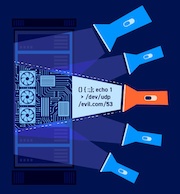DAST
Creating a configuration file for a CI-driven scan
-
Last updated: December 16, 2025
-
Read time: 9 Minutes
We provide a template configuration file. The file includes comments to help you to understand and edit each of the parameters. After you edit the configuration file, you can rename it to burp_config.yml, to match the integration examples we give in this section.
You can get the template YAML file here (opens in a new tab):
Mandatory settings
Mandatory settings define what Burp Suite DAST should scan. These settings vary depending on whether you're scanning a web app or an API. If you only define mandatory settings when scanning an API definition, Burp Scanner uses the default scan configuration.
Common requirements
For all CI-driven scans, you must specify a DAST server URL and API key (enterpriseServer.url and enterpriseServer.apiKey). For more information, see Creating API users.
Web apps
For web app scans, you must provide start URLs (site.startUrls). These are the URLs that Burp Scanner starts scanning from.
APIs
You can add API definitions by either uploading a file (site.apiDefinition.fromFile) or providing a URL (site.apiDefinition.fromUrl). You must provide one of these properties when running a CI-driven scan on an API definition.
For API scans, Burp Suite DAST supports:
- Postman Collections
- OpenAPI definitions in JSON or YAML format
- SOAP WSDLs
Note
Burp Suite DAST scans all endpoints referenced in the API definition file. To exclude endpoints from scans, remove them from the API definition file before running the scan.
We fully support OpenAPI 3.1 and provisionally support OpenAPI 3.2.
Proxy settings
If you need to use a proxy to connect to your DAST server, add the URL and authentication credentials into the following fields. The authentication credentials are optional:
proxyUrlproxyUsernameproxyPassword
Defining the scope
Burp Scanner only visits URLs that are in scope. Use the YAML file to set the scope of your scan, to make sure Burp Scanner only visits URLs that you have permission to scan. You can also use the scope to focus on particular paths that you're interested in.
To define the scope, enter URLs as values in the site.inScopeUrlPrefixes or site.outOfScopeUrlPrefixes parameters.
Note
The start URLs are automatically added to the site.inScopeUrlPrefixes parameter.
Public key certificate
If your Burp Suite DAST server is configured with a self-signed or private CA TLS certificate, you can add this to the enterpriseServer.tlsCertificate parameter. This verifies the certificate received from your server, to make sure your scan results are transmitted over a secure connection.
Alternatively, you can add the TLS certificate as an environment variable in your docker run command. For more information, see Getting started with CI-driven scans.
Authentication
You can use authenticated scanning to scan content that is behind authentication. We support the following methods of authentication:
Login credentials (web apps only)
To define login credentials, enter a list of username and password pairs in the logins.loginCredentials setting.
Recorded logins (web apps only)
To define a recorded login sequence:
- Record a login sequence and save it to the clipboard.
- Save the contents of the clipboard as a JSON file in the same directory as the configuration file.
-
In the
logins.recordedLoginsparameter, enter the path to the JSON file.
In the logins.recordedLogins parameter, enter the path to the JSON file.
API authentication (APIs only)
You can manage API authentication for CI-driven scans by adding the authentication details directly into the CI configuration YAML file. Burp Suite DAST supports the following methods of API authentication.
API key authentication
When configuring API key authentication for CI-driven scans, you need to determine whether the authentication method is already defined in your API definition.
If your OpenAPI definition file already includes the authentication scheme, you only need to add the label and key fields to your configuration file, regardless of whether the key is passed in the header, a query parameter, or a cookie.
-
label: Use the exact label from the API definition file. -
key: Enter the API key value required by the API.
For SOAP WSDLs, Postman Collections, or OpenAPI definition files that don't include the authentication scheme, you must define all the necessary fields in your configuration file:
-
API key in Header:
label: Create a unique name for the authentication scheme. For example,headerAuth1.type: This must beapiKey.in: This must beheader.name: Specify the name of the header where the API key will be placed. For example,X-API-Key.key: Enter the API key value. For example,AKIA9672010EXAMPLE.
-
API key in Query Parameter:
label: Create a unique name for the authentication scheme. For example,queryAuth1.type: This must beapiKey.in: This must bequery.name: Specify the name of the query parameter where the API key will be placed. For example,api_key.key: Enter the API key value. For example,AKIA7040551EXAMPLE.
-
API key in Cookie:
label: Create a unique name for the authentication scheme. For example,cookieAuth1.type: This must beapiKey.in: This must becookie.name: Specify the name of the cookie where the API key will be placed. For example,api_key_cookie.key: Enter the API key value. For example,AKIA1329734EXAMPLE.
HTTP authentication types
When configuring HTTP authentication for CI-driven scans, you need to determine whether the authentication method is already defined in your API definition.
If your API definition file already includes the HTTP authentication scheme, you only need to add the label, username, and password (for Basic Authentication) or the label and token (for Bearer Token) fields to your configuration file:
-
Basic Authentication:
label: Use the exact label from the API definition file.username: Specify the username required by the API.password: Specify the corresponding password.
-
Bearer Token Authentication:
label: Use the exact label from the API definition file.token: Specify the bearer token required by the API.
If your API definition file doesn't include the HTTP authentication scheme, you must define all the necessary fields in your configuration file:
-
Basic Authentication:
label: Create a unique name for the authentication scheme. For example,basicAuth1.type: This must behttp.scheme: This must bebasic.username: Specify the username required by the API. For example,carlos@portswigger.net.password: Specify the corresponding password for the username.
-
Bearer Token Authentication:
label: Create a unique name for the authentication scheme. For example,bearerAuth1.type: This must behttp.scheme: This must bebearer.token: Specify the bearer token required by the API. For example,f5cCI6iCJ9.eyJzdWIiOiIxMjM0...(this is a shortened example, actual tokens are generally much longer).
Dynamic authorization
The authentication scheme for bearer tokens and API keys may use dynamic authorization tokens. These tokens have a limited lifespan. You can configure the scanner to fetch refreshed tokens automatically using the dynamicTokenConfig field.
-
Dynamic token configuration:
-
url: Enter the URL for the authentication service. -
method: Enter the methodgetorpost. -
headers: If necessary, specify an array of additional headers, each with anameandvaluefield. -
body: If necessary, add the body of the request. -
extractPath: Enter the location in the response where the token will be located. For JSON responses, enter the dot-separated path to the field in the JSON document. For XML responses, enter an XPath expression. -
refreshInterval: Enter a value for how often the token should be refreshed, in seconds.
-
Scan configuration
You can select from built-in scan configurations, or you can use your own custom scan configuration.
Selecting a built-in scan configuration
You can select from the list of built-in scan configurations. These are the same built-in scan configurations used by Burp Suite DAST and Burp Suite Professional.
If you don't select a built-in scan configuration, the default configuration is used.
To use a built-in scan configuration, enter the name of the configuration in the scanConfigurations.builtIn setting. The configuration names are case-sensitive.
Selecting a custom scan configuration
You can create custom scan configurations in Burp Suite DAST and Burp Suite Professional. You can then export the scan configuration as a JSON file. For more information, see Using custom scan configurations.
Once you have created a custom scan configuration, save it as a JSON file in the same directory as the configuration file. Enter the path for the JSON file in the scanConfigurations.custom parameter.
Note
If you select more than one scan configuration, Burp Scanner combines the settings from these scan configurations. If settings in two or more scan configurations conflict, the setting from the lowest configuration in the list takes precedence.
Using custom extensions, BChecks, and BApps with CI-driven scans
You can apply custom extensions, BChecks, and BApps to your CI-driven scans. This enables you to implement custom scan behaviors and capabilities.
For more information about extensions, see Extensions in Burp Suite DAST.
Warning
For security reasons, only use custom extensions, BChecks, and BApps that you trust.
To use custom extensions, BChecks, and BApps with your CI-driven scans:
-
Upload the custom extensions, BChecks, and BApps to the same directory as your
burp_config.ymlconfiguration file. You can upload multiple files to the directory. -
In your configuration file, list the filenames of the custom extensions and BApps that you want to apply to your scan under
extensions.filenames. You can list zero or more custom extensions and BApps. -
List the filenames of the BChecks that you want to apply to your scan under
bchecks.filenames. You can list zero or more BChecks.
Configuring connection settings
The JSON file contains some parameters that enable you to configure the connection settings used when running CI-driven scans:
-
headersCookiesConfigenables you to add a list of custom headers and cookies to requests made when scanning a site. This enables you to, for example, configure header authentication. For more information on configuring request headers and cookies, see Adding headers and cookies. -
platformAuthenticationenables you to add authentication credentials for HTTP Basic and NTLM authentication. For more information on the settings available, see Configuring platform authentication. -
proxiesenables you to enter a list of upstream proxy servers for the connection to use. For more information on the settings available, see Configuring upstream proxy servers.
Viewing scan results in the dashboard
If you want to view the progress and results of scans in the Burp Suite DAST dashboard, you must provide a correlation ID (site.correlationId). Burp Suite DAST creates a site with the same name as your correlation ID. You can choose any unique text string for the correlation ID, up to 64 characters long.
When you create a site, you can also set the folder ID (folderId) where the site will be saved. You need to create the folder first using the Burp Suite DAST dashboard. From the dashboard, click the folder to see the folder ID. If you don't set the folder ID, the site is saved in the root folder.
Note
You can edit the site or folder names later, but the correlation ID and folder ID stay the same. The names and IDs are shown in the Details tab for your site or folder.
If you don't provide a correlation ID, Burp Suite DAST doesn't show the progress or results of your scans. The scan data is only saved to the burp_junit_report.xml file.
Specifying report format
By default, CI-driven scans output reports in JUnit XML format. However, they can also output in Burp XML format if required. Use the reporting.reportFormats parameter to specify the format to use.
Ignoring specific vulnerabilities
You can ignore specific vulnerabilities, so that they do not cause the build to fail. Burp Scanner still looks for these vulnerabilities, and records them in the results. For a list of vulnerabilities, see Vulnerabilities detected by Burp Scanner.
Enter the name of the vulnerabilities in the reporting.ignoredIssues parameter. Names are case-sensitive. If you name an issue and don't supply a path, the issue is ignored everywhere.
We support the use of regex for the paths.
Setting the threshold
You can set a threshold that causes Burp Scanner to tell your CI/CD system to fail the pipeline step.
To enable a threshold, set reporting.threshold.enabled to TRUE. Then enter a minimum severity and a minimum confidence. If Burp Scanner detects an issue with at least this severity and confidence, it finishes with a non-zero exit code.
You can set the reporting.threshold.enabled to:
-
TRUE -
FALSE
You can set the threshold.minimumSeverity to:
-
INFO -
LOW -
MEDIUM -
HIGH
You can set the threshold.minimumConfidence to:
-
TENTATIVE -
FIRM -
CERTAIN
If you don't input values for these parameters, the default values are TRUE, LOW, and
TENTATIVE.
Configuring output detail level
The verboseScanning parameter controls the amount of detail provided in scan output:
-
When
verboseScanningis set toenabled: true, the scan produces detailed output, making it easier to troubleshoot and gain deeper insights into what the scan is doing. -
When
verboseScanningis set toenabled: false, the scan produces minimal output, showing only the most important information. This mode is useful for routine scans where detailed information is not necessary. This is the default option.


